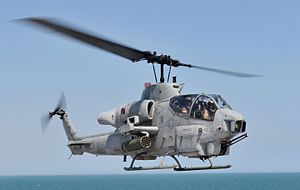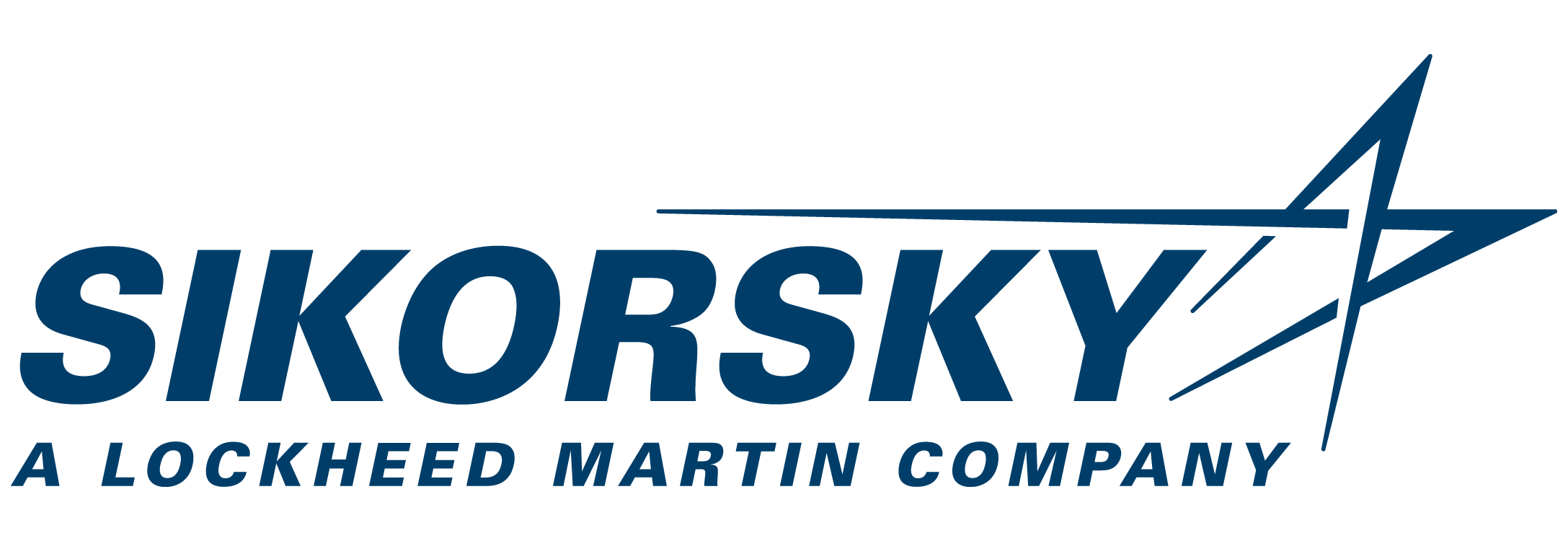

AH-1J,T,W (Bell 309) Super Cobra/”Snake” Helicopter
The Bell AH-1 SuperCobra is a twin-engine attack helicopter based on the United States Army’s single-engine AH-1 Cobra. The twin Cobra family, itself part of the larger Huey family, includes the AH-1J SeaCobra, the AH-1T Improved SeaCobra, and the AH-1W SuperCobra. The AH-1W, the backbone of the United States Marine Corps’s attack helicopter fleet for decades is being replaced by the next generation Bell AH-1Z Viper attack helicopter.
The AH-1 Cobra was developed in the mid-1960s as an interim gunship for the U.S. Army for use during the Vietnam War. The Cobra shared the proven transmission, rotor system, and the T53 turboshaft engine of the UH-1 “Huey”.[2] By June 1967, the first AH-1G HueyCobras had been delivered. Bell built 1,116 AH-1Gs for the U.S. Army between 1967 and 1973, and the Cobras chalked up over a million operational hours in Vietnam.[2]
The U.S. Marine Corps was very interested in the AH-1G Cobra, but it preferred a twin-engine version for improved safety in over-water operations, and also wanted a more potent turret-mounted weapon. At first, the Department of Defense had balked at providing the Marines with a twin-engine version of the Cobra, in the belief that commonality with Army AH-1Gs outweighed the advantages of a different engine fit. However, the Marines won out and awarded Bell a contract for 49 twin-engine AH-1J SeaCobras in May 1968. As an interim measure, the U.S. Army passed on 38 AH-1Gs to the Marines in 1969.[3] The AH-1J also received a more powerful gun turret. It featured a three barrel 20 mm XM197 cannon that was based on the six barrel M61 Vulcan cannon.[4]
“As I perused your site, I was impressed with the historical timeline of the AH-1 Cobra. As a retired U.S. Army Aviator and qualified snake driver, I wish to add a small piece of Information about the AH-1S(P) Cobra.
The New Equipment Training Team (NETT) came to Ft. Campbell, KY in the fall of 1977 to qualify AH-1G pilots In the then new AH-1S(P). P was the designation attached signifying Production. The (P) Model was the first of the original new built AH-1s with the T-703 engine, square plate canopy, TOW system and M-28 Turret. AH-1Gs were modified with the new engine and had the TOW system installed but kept the original round canopy. As such they were AH-1S (Modified). I was assigned to A Co. 4/77 at Ft. Campbell during this time period as an Aviation Maintenance Warrant Officer and received a AH-1(P) qualification in November of 1977 as shown in my flight records. CW3 Les Haas and myself were selected to go down to Globe Field, Arlington, TX at the Bell Plant, accept and fly the first two assigned AH-1S(P) aircraft to Ft. Campbell, KY in the early spring of 1978. When the other eight S models arrived, all were packed up and sent to the Federal Republic of Germany for REFORGER 1978 in July of that year. An interesting side note as one who flew both the AH-1G and AH-1S(P), the (P) was slower in straight flight and dives than the AH-1G Cobra. That was due to the flat plate canopy of the (P). It increased the drag by a considerable amount. The flat plate canopy was installed to minimalize to glare off the canopy. It helped. I hope this helps. Dan Brunger CW4, USA (Ret.)“
An AH-1T Sea Cobra launching from the amphibious assault ship Iwo Jima.
The Marine Corps requested greater load carrying capability in high temperatures for the Cobra in the 1970s. Bell used systems from its Model 309 to develop the AH-1T. This version had a lengthened tailboom and fuselage with an upgraded transmission and engines from the 309. Bell designed the AH-1T to be more reliable and easier to maintain in the field. The version was given full TOW missile capability with targeting system and other sensors. An advanced version, known as the AH-1T+ with more powerful T700-GE-700 engines and advanced avionics was proposed to Iran in the late 1970s, but the overthrow of the Shah of Iran resulted in the sale being canceled.[4]
In the early 1980s, the U.S. Marine Corps sought a new navalized helicopter, but it was denied funding to buy the AH-64 Apache by Congress in 1981. The Marines in turn pursued a more powerful version of the AH-1T. Other changes included modified fire control systems to carry and fire AIM-9 Sidewinder and AGM-114 Hellfire missiles. The new version was funded by Congress and received the AH-1W designation.[4] Deliveries of AH-1W SuperCobras totaled 179 new-built helicopters plus 43 upgrades of AH-1Ts.[5]
The AH-1T+ demonstrator and AH-1W prototype were later tested with a new experimental composite four-blade main rotor system. The new system offered better performance, reduced noise and improved battle damage tolerance. Lacking a USMC contract, Bell developed this new design into the AH-1Z with its own funds. By 1996, the Marines were again not allowed to order the AH-64.[4] Developing a marine version of the Apache would have been expensive and it was likely that the Marine Corps would be its only customer.[2] They instead signed a contract for upgrading AH-1Ws into AH-1Zs.[4]
The Bell AH-1Z Viper features several design changes. The AH-1Z’s two redesigned wing stubs are longer with each adding a wingtip station for a missile such as the AIM-9 Sidewinder. Each wing has two other stations for 70 mm (2.75 in) Hydra rocket pods, or AGM-114 Hellfire quad missile launcher. The Longbow radar can be mounted on a wingtip station.[2] The AH-1W version will be phased out of the Marine Corps by 2020.[6]
During the closing months of the United States’ involvement in the Vietnam War, the Marine Corps embarked the AH-1J SeaCobra assigned to HMA-369 (now HMLA-369) aboard Denver, Cleveland, and later Dubuque, for sea-based interdiction of the Ho Chi Minh Trail in North Vietnam in the vicinity of Hon La (Tiger) Island. These were termed Marine Hunter-Killer (MARHUK) Operations and lasted from June to December 1972.[7]
Marine Cobras took part in the invasion of Grenada, during Operation Urgent Fury in 1983, flying close-support and helicopter escort missions. Two Marine AH-1Ts were shot down and three crew members killed.[4] The Marines also deployed the AH-1 off the coast of Beirut, Lebanon in 1983, during that nation’s civil war. The AH-1s were armed with Sidewinder missiles and guns as an emergency air defense measure against the threat of light civil aircraft employed by suicide bombers.[8]
USMC Cobras provided escort in the Persian Gulf in the late 1980s while the Iran–Iraq War was ongoing. The Cobras sank three Iranian patrol boats while losing one AH-1T to Iranian anti-aircraft fire.[4] USMC Cobras from Saipan flew “top cover” during an evacuation of American and other foreign nationals from Liberia in 1990.[4]
During the Gulf War, 78 Marine SuperCobras deployed, and flew a total of 1,273 sorties in Iraq[9] with no combat losses. However, three AH-1s were lost to accidents during and after the combat operations. The AH-1W units were credited with destroying 97 tanks, 104 armored personnel carriers and vehicles, and two anti-aircraft artillery sites during the 100-hour ground campaign.[4]
U.S. Marine AH-1W SuperCobras refuel in April 2003, during the invasion of Iraq.
Marine Cobras provided support for the US humanitarian intervention in Somalia, during Operation Restore Hope in 1992–93. They were also employed during the U.S. invasion of Haiti in 1994. USMC Cobras were used in U.S. military interventions in the former Yugoslavia in the 1990s, and two AH-1Ws assisted in the rescue of USAF Captain Scott O’Grady, after his F-16 was shot down by a SAM in June 1995.[10]
AH-1 Cobras continue to operate with the U.S. Marine Corps. USMC Cobras were also used in operations throughout the 1990s.[4] USMC Cobras have also served in Operation Enduring Freedom in Afghanistan and in Operation Iraqi Freedom in the conflict in Iraq. While new replacement aircraft were considered as an alternative to major upgrades of the AH-1 fleet, Marine Corps studies showed that an upgrade was the most affordable, most supportable and most effective solution for the Marine Corps light attack helicopter mission.[11]
During the March 2003 Iraq campaign, 46 of 58 USMC Cobras took battle damage, mostly from infantry-type weapons.[12]
On 19 September 2011, an AH-1W crashed during training exercises at Camp Pendleton, California, killing the two Marine crewmembers on board.[13] An investigation into the crash determined that it was caused by bird strike.[14] The aircraft collided with a red-tailed hawk, the impact damaging the pitch change link which in turn produced vibrations to the rotors so fierce that they caused the transmission and rotors to break off from the helicopter body.[14]
In late August 2016, Marine AH-1W Cobras flying from the USS Wasp started flying combat missions over Sirte, Libya against the Islamic State of Iraq and the Levant in Libya, providing close air support for friendly militias on the ground.[15]
Twin-engine[edit]
AH-1W on a training mission at the Mojave Spaceport
AH-1J SeaCobra
Original twin engine version.
AH-1J International
Export version of the AH-1J SeaCobra.
AH-1T Improved SeaCobra
Improved version with extended tailboom and fuselage and an upgraded transmission and engines.
AH-1W SuperCobra
(“Whiskey Cobra”), day/night version with more powerful engines and advanced weapons capability.
AH-1(4B)W Viper
“Four-Bladed Whiskey” test version with a four-bladed bearingless composite main rotor based on Bell 680 rotor. A prototype was converted from AH-1T 161022.[33]
AH-1Z Viper
A new variant nicknamed “Zulu Cobra”, and developed in conjunction with the UH-1Y Venom for the H-1 upgrade program. The variant includes an upgraded four-blade main rotor and adds the Target Sight System (TSS).
Bell 309 KingCobra
Experimental all-weather version based on the AH-1G single-engine and AH-1J twin-engine designs.[34] Two Bell 309s were produced; the first was powered by a PW&C T400-CP-400 Twin-Pac engine set and the second was powered by a Lycoming T-55-L-7C engine.[35]
